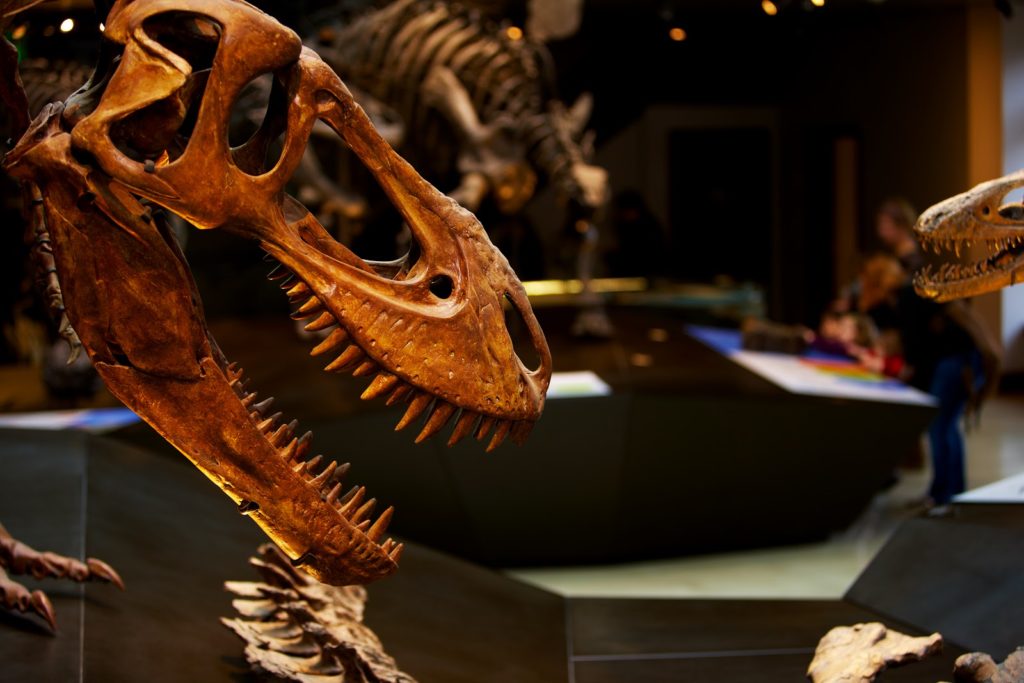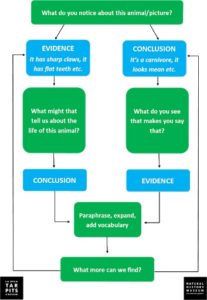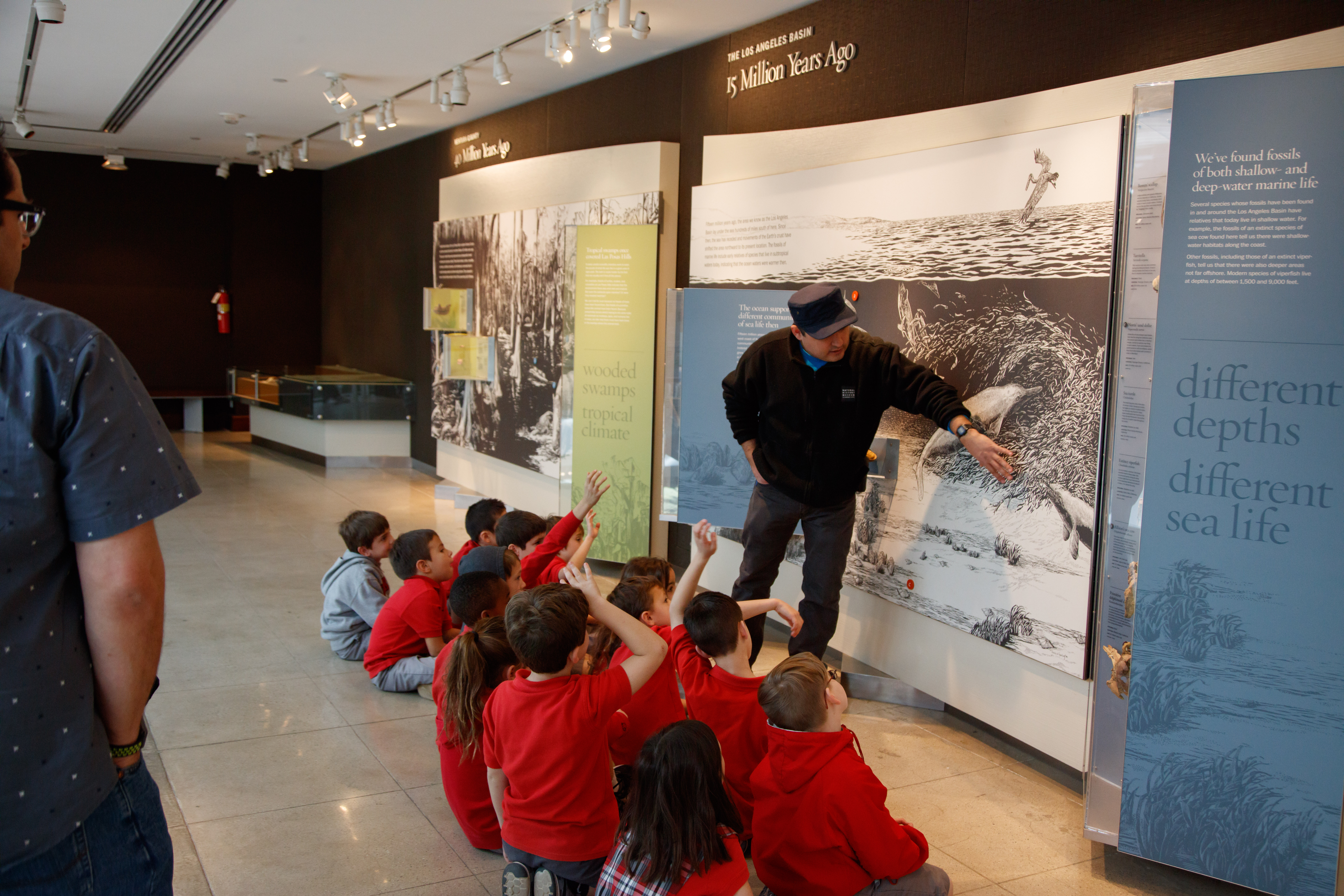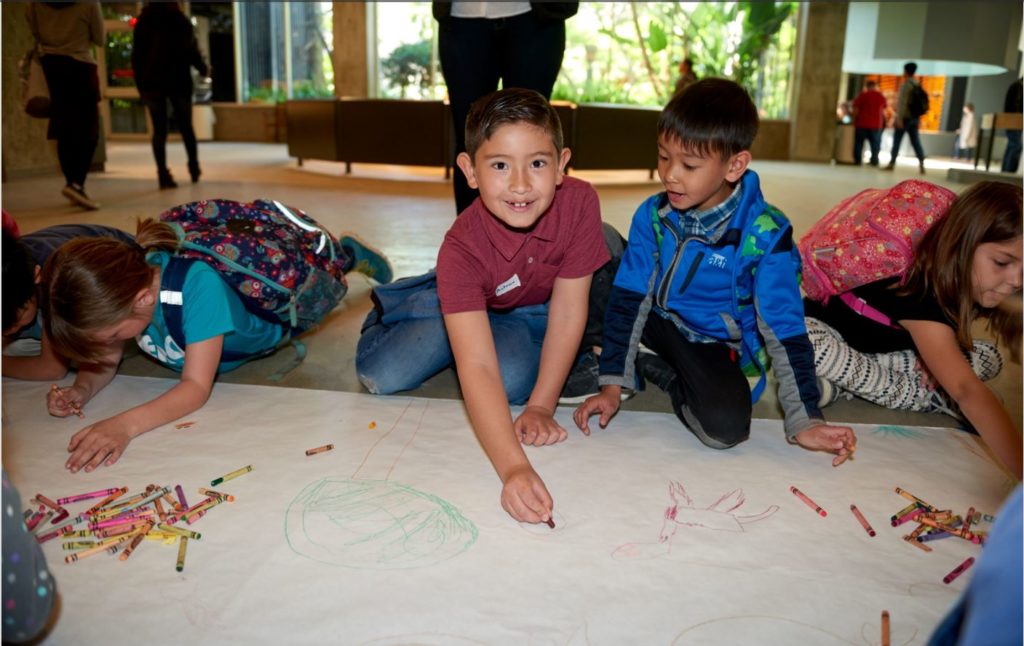Early in my time at the Natural History Museum of Los Angeles County (NHMLA), I had the pleasure of creating a whole new suite of guided programs for the PreK–12 audience and I took the opportunity to experiment with an entirely new approach. As someone with an art history background, I instinctively wanted to explore the integration of visual art practices in my new (and a bit strange to me) science education environment. At first glance, you might not think there is a lot of narrative inherent in a T. rex skeleton, and What is going on here? wouldn’t be your first question as you approach this colossal, Cretaceous creature. When I first began toying with the idea of bringing Visual Thinking Strategies into a natural history museum environment, I grappled with this as well.
I had encountered VTS in my graduate work, but had never used it in a museum setting. While it may not seem obvious, the parallels between the skills one needs for effective scientific observation and the skills at the heart of the practice of VTS felt strong enough to explore. Like VTS, science asks us to process visual information, make inferences, seek meaning in the unknown, and engage in shared discourse. Perhaps even more important to me, however, were the intangibles, the values that VTS represents: student-centered learning in an open and accepting environment, where every comment is heard and validated. Ultimately, I hoped that students would leave the program with a greater sense of agency, as in, “I can do this. I can do science.”
Acknowledging all of the potential in these connections, my team of program coordinators and I began exploring a program outline with VTS at its core. Since dinosaurs are one of the most popular topics for our school field trips (and all of our visitors), it felt natural to start there. We began to construct a narrative that would help students think about what it’s like to discover a dinosaur fossil or ancient mammal bone, and how looking at it can help us imagine what it was like as a living, breathing animal, millions of years ago.
 When paleontologists find fossils, there isn’t a label in the earth next to them, so the process of deciphering information from visual evidence is an authentic practice. Authenticity is a core value of NHMLA and something we strive for in all of our programs, but as I mentioned at the outset, asking the first question (Q1), What is going on here? can be challenging when faced with a fossil skeleton. Unlike works of art, examining single objects with this type of prompt does not always elicit the desired response. We began to explore a question (or questions) that preserved the environment of VTS, but allowed for a better entry point for our audience, 2nd–5th graders. We selected: What do you notice about this animal? Typically, VTS facilitators, myself included, avoid the word “notice” because it can prompt simple listing, but this seemed to solicit the right type of information (observations) and allowed students to feel empowered to share without fear of giving a wrong answer.
When paleontologists find fossils, there isn’t a label in the earth next to them, so the process of deciphering information from visual evidence is an authentic practice. Authenticity is a core value of NHMLA and something we strive for in all of our programs, but as I mentioned at the outset, asking the first question (Q1), What is going on here? can be challenging when faced with a fossil skeleton. Unlike works of art, examining single objects with this type of prompt does not always elicit the desired response. We began to explore a question (or questions) that preserved the environment of VTS, but allowed for a better entry point for our audience, 2nd–5th graders. We selected: What do you notice about this animal? Typically, VTS facilitators, myself included, avoid the word “notice” because it can prompt simple listing, but this seemed to solicit the right type of information (observations) and allowed students to feel empowered to share without fear of giving a wrong answer.
Here, we faced our next challenge. What would we use for the second question (Q2) What do you see that makes you say that? It was easy enough for students to make observations—“It’s big!” “It has four legs.”—but it seemed almost silly to follow up with What do you see that makes you say that? How could they answer? “Well, I see that it has four legs.” We still needed the function of Q2, however, to help the students think together about how that observation could help us understand more about the animal and the past. We landed on this: What might that tell us about the life of this animal? Or a slight variation, such as, What might that tell us about how this animal lived? In order to avoid putting the specific student on the spot and to encourage the group’s critical thinking process, we pose this question to the group as a whole.
Sometimes, the “classic” Q2, What do you see that makes you say that?, still works perfectly. If a student makes an observation such as “It’s a carnivore,” that is a great time to follow up with: “You’re thinking this animal might have been carnivorous, what do you see that makes you say that?” As with art-based VTS, this Q2 allows the student to examine their own thinking process; note that in this example, perhaps, the sharp teeth in the skull would have led the student to propose that the animal would have eaten meat.
A few years back, in training sessions with our museum educators, we identified a need to help streamline or clarify when to use the classic VTS Q2 What do you see that makes you say that? and when to use the NHMLA modified Q2 What might that tell us about how this animal lived? Once we broke down the types of comments we were hearing during the program, it turned out to be a fairly clear delineation. Students typically give one of two types of responses: one is a statement of direct observation: “It has four legs”—which can be categorized as an evidence statement. The other type of response is already a conclusion statement: “I think it was a carnivore.” Conclusion statements can be supported by the classic Q2 very nicely, whereas evidence statements are better supported by the modified Q2, What might that tell us about how this animal lived? We heard back from our educators that having mental frames for these two types of statements was very helpful in regards to paraphrasing and selecting the appropriate follow up question.
 We’ve been running this foundational program, called Fossil Detectives, for over 8 years. Naturally, we’ve learned, refined, and changed a lot over the years, including how to sequence our conversations to best support learners. In the program as it stands now, we have a progression of three conversations with students beginning at a mural depicting an ancient, paleo environment, followed by discussions of two, fully reconstructed skeletons that would have lived in that particular environment. This progression allows the first conversation to be a “classic,” or more straightforward version of VTS, because, with multiple animals and habitat interactions, there is more narrative available in the murals. The students also get a sense of the dialogue in which there are no wrong answers. Once the students have a visual reference for the ancient animals’ habitat and are feeling settled in the process itself, they are more prepared to think about the individual skeletons.
We’ve been running this foundational program, called Fossil Detectives, for over 8 years. Naturally, we’ve learned, refined, and changed a lot over the years, including how to sequence our conversations to best support learners. In the program as it stands now, we have a progression of three conversations with students beginning at a mural depicting an ancient, paleo environment, followed by discussions of two, fully reconstructed skeletons that would have lived in that particular environment. This progression allows the first conversation to be a “classic,” or more straightforward version of VTS, because, with multiple animals and habitat interactions, there is more narrative available in the murals. The students also get a sense of the dialogue in which there are no wrong answers. Once the students have a visual reference for the ancient animals’ habitat and are feeling settled in the process itself, they are more prepared to think about the individual skeletons.

One thing I feel I should note is that it is important to us that it doesn’t feel like we’re trying to trick the students with the unknown in this setting. They know that we know what the animal is (triceratops, ground sloth, saber-toothed cat, etc.), but it’s not their job to know that simply by looking. To focus and support the students looking closely at the animal, we can tell them what the animal is at the beginning of the conversation to remove that assumption and refocus the students on looking closely at the animal. In this way, we are better able to help them practice critical thinking skills by basing their observation on visual evidence.
Our efforts to integrate VTS at NHMLA coincided with the advent of the Common Core State Standards and predated the Next Generation Science Standards by a few years. Luckily, our work very nicely supports both sets of standards in foundational skill building and shared values: speaking and listening, arguing from evidence, asking and answering questions, and observing, to name a few. As teachers are shifting their pedagogy to be more process-based, our work as informal educators can model this dialogic practice with their students, providing a methodology that they can take back into the classroom and use with a variety of subject matter. To this end, we provide an educator guide to Fossil Detectives that teachers receive at the beginning of the program, which includes both VTS basic information as well as our NHM adaptations and program goals.
 We know that one important difference between a museum program and VTS in the classroom is our limited time with the students, so we have designed the program to maximize the benefit to the students. As we paraphrase their evidence or conclusion statements, we add scientific vocabulary and validate their possible hypothesis about the ancient world and the life in it. In order to help them process and synthesize their thoughts, we allow for time journaling and drawing, documenting their observations as well as those they heard from their classmates. We also encourage them to capture any questions that emerged from the discussion that they would like to research further. In our brief 45 minutes with them, we hope to take even small steps to enact our museum’s vision by inspiring wonder and discovery about the natural world. After the program, we send them on their way, empowering students to explore the rest of the museum (and the world) with close looking and curiosity.
We know that one important difference between a museum program and VTS in the classroom is our limited time with the students, so we have designed the program to maximize the benefit to the students. As we paraphrase their evidence or conclusion statements, we add scientific vocabulary and validate their possible hypothesis about the ancient world and the life in it. In order to help them process and synthesize their thoughts, we allow for time journaling and drawing, documenting their observations as well as those they heard from their classmates. We also encourage them to capture any questions that emerged from the discussion that they would like to research further. In our brief 45 minutes with them, we hope to take even small steps to enact our museum’s vision by inspiring wonder and discovery about the natural world. After the program, we send them on their way, empowering students to explore the rest of the museum (and the world) with close looking and curiosity.

